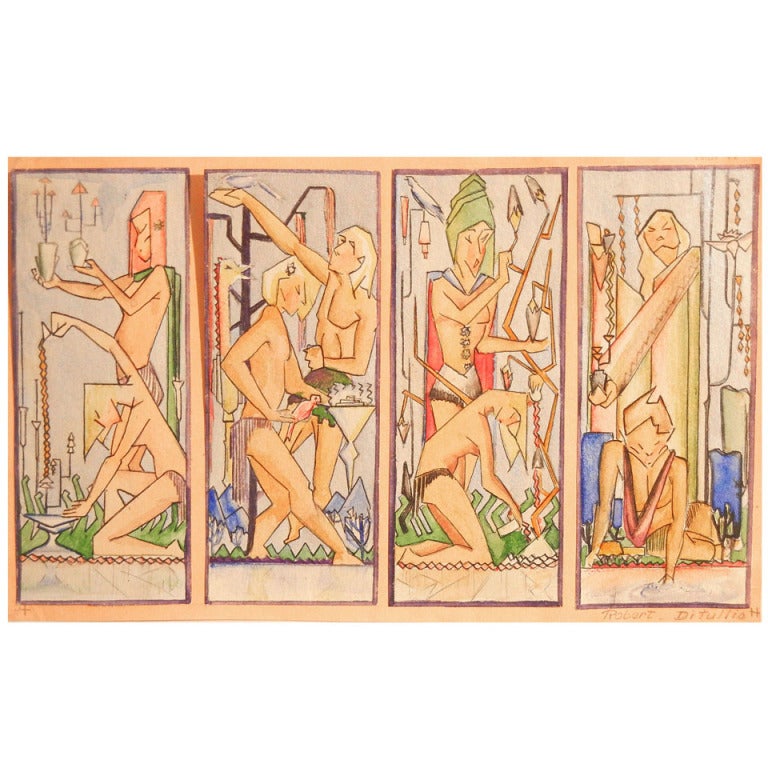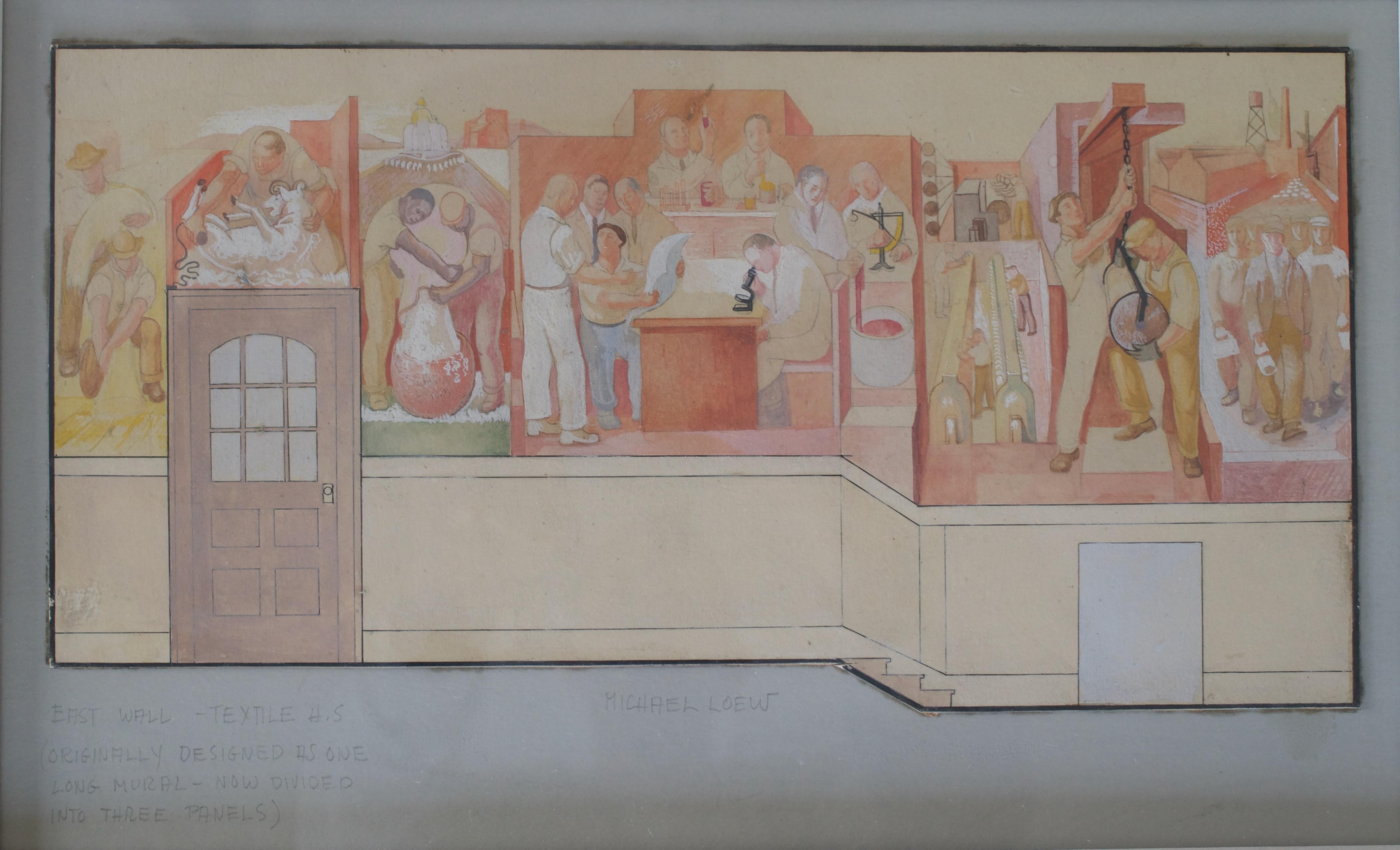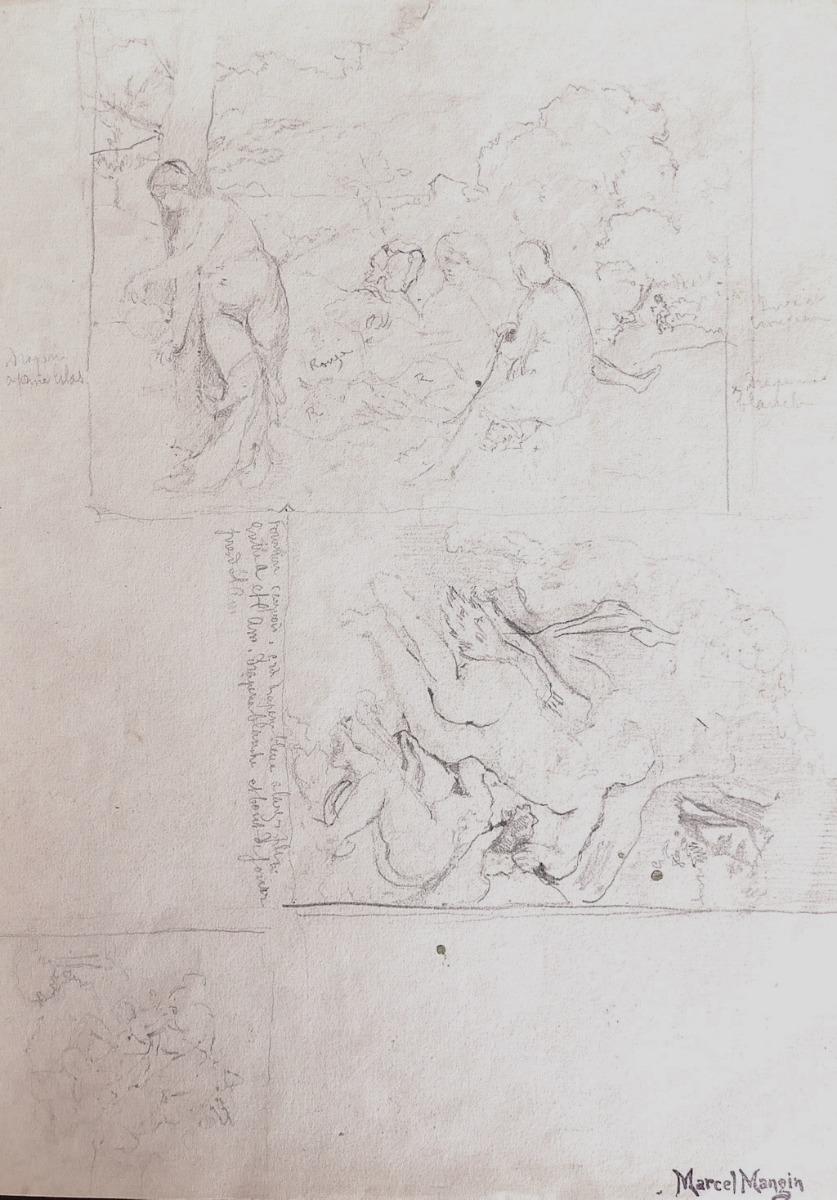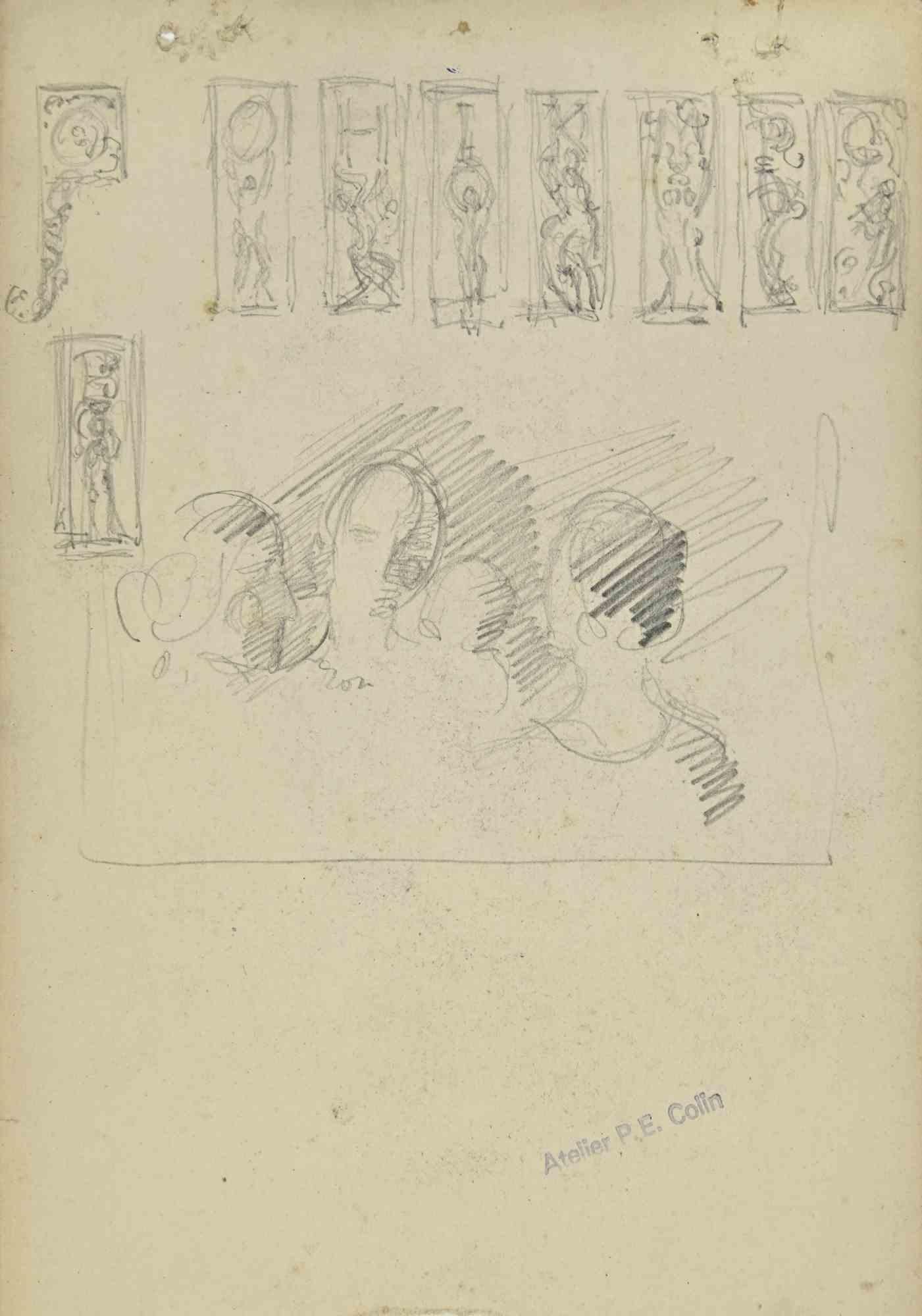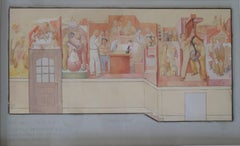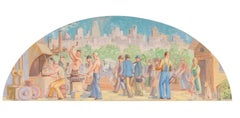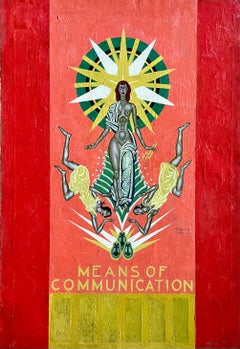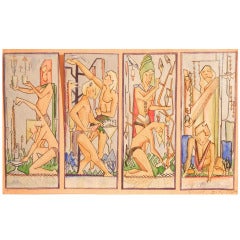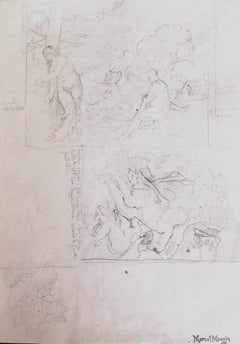Items Similar to Mural Studies, Palace of Fine Arts San Francisco WPA American Modernism 1930s
Want more images or videos?
Request additional images or videos from the seller
1 of 9
Frank Van SlounMural Studies, Palace of Fine Arts San Francisco WPA American Modernism 1930sc. 1936
c. 1936
$2,500
£1,879.34
€2,178.75
CA$3,490.39
A$3,909.42
CHF 2,034.20
MX$47,479.64
NOK 25,788.50
SEK 24,333.38
DKK 16,256.58
Shipping
Retrieving quote...The 1stDibs Promise:
Authenticity Guarantee,
Money-Back Guarantee,
24-Hour Cancellation
About the Item
Mural Studies, Palace of Fine Arts San Francisco WPA American Modernism 1930s. 9 x 12 inches. Tempera on paper, c. 1936. Authenticated and signed verso by the artist’s sister, Katherine Van Sloun Fortune.
A painter, muralist, etcher and educator, Frank Van Sloun, living in San Francisco, became especially noted for his murals and for being the principal West Coast exponent of Social Realism. Described as being a painter of "contemporary, raw, hearty figure pieces and urban scenes" (Gerdts 282), Van Sloun learned about Social Realism in New York City under the tutelage of Robert Henri and other members of the Ashcan School.
During his career, Van Sloun experimented with a variety of styles and mediums including Impressionism, Realism, Pointillism and pastel, oil, tempera, watercolor, gouache, monotypes and etchings. The artist was also highly respected for his teaching abilities, and is credited with bringing the credo "art for art's sake" of his mentor, Robert Henri, to the Bay Area where Van Sloun, like Henri in New York, encouraged students to follow their own inclinations and not copy-cat his methods and subjects.
Frank Van Sloun was born in 1879 in St. Paul, Minnesota, where he attended grammar and high schools and from an early age, showed obvious talent and dedication to both art and sports. He studied at the St. Paul School of Fine Arts, and one of his influential painting teachers there was Ebenezer Comins. After two years, succumbing to his love of sports, he signed on with the St. Paul professional baseball team. However, he quickly did another turn around, and at age 22, enrolled in art classes at the Art Students League in New York City. For four years, he studied with painter and teacher Robert Henri, who was promoting Social Realists subjects of of everyday people going about their ordinary, less-than-glamourous lives. He also studied at the Chase School of Art, established by William Merritt Chase.
In New York, Frank Van Sloun joined the Society of Independent Artists, a group rebelling against the conservative trends of the National Academy of Design. In 1910, he helped Henri and other modernist artists organize the first exhibition of the Society.
Between 1907 and 1908 Van Sloun spent six months in San Francisco, California, his first visit to that state, and by 1911, he had established a studio there. He taught drawing, illustration and composition at the California School of the Fine Arts in 1917, and exhibited his work at the San Francisco Art Association's Fifty-Fifth Annual Exhibition. In 1926, he joined the faculty of the University of California, Berkeley and maintained a home studio at 1617 California Street. He also maintained his ties with New York City, and spent the year of 1919 teaching at the Art Students League.
In 1914 Frank Van Sloun received his first mural commission, which was for the Mayor's office in the city of Oakland, California. The two-part mural decoration depicted the scene of a pioneer family. He continued painting on canvas, and in 1915 was awarded a bronze medal at the Panama-Pacific International Exposition in San Francisco. His first solo exhibition was held the following year at the Helgesen Gallery in San Francisco.
He was an active contributor to the Bohemian Club of San Francisco and was elected to their board of directors in 1922. He painted many murals for the club, enhancing the walls and over-mantels of its interior. In 1926 he partnered with Maynard Dixon on a set of commissioned murals for the Mark Hopkins Hotel in San Francisco. The nine panels in "The Room of the Dons" showed the history of California and, an installation that took nine months to complete.
Van Sloun continued to paint murals for various California institutions including the California War Memorial Library building in Sacramento (1928); and the Greek inspired decorations for the Palace of Fine Arts in San Francisco (1936). He believed that his more minor works such as easel paintings, etchings and monotypes were just preparations for the larger mural paintings that would be on view to the public. He was more concerned with public approval for his murals than critical acclaim for his smaller works.
While preparing murals for the Golden Gate International Exposition of 1939 -1940, Frank Van Sloun died on August 27, 1938.
Memberships in California included the San Francisco Art Association, the Carmel Art Association, Bohemian Club, Society of Mural Painters and the California Society of Etchers.
- Creator:Frank Van Sloun (1879 - 1938, American)
- Creation Year:c. 1936
- Dimensions:Height: 21 in (53.34 cm)Width: 25 in (63.5 cm)Depth: 1 in (2.54 cm)
- Medium:Paper,Egg Tempera
- Movement & Style:
- Period:
- Condition:
- Gallery Location:New York, NY
- Reference Number:1stDibs: LU115629027732
About the Seller
5.0
Gold Seller
Premium sellers maintaining a 4.3+ rating and 24-hour response times
Established in 2008
1stDibs seller since 2019
191 sales on 1stDibs
Typical response time: <1 hour
- ShippingRetrieving quote...Shipping from: Pawling, NY
- Return Policy
Authenticity Guarantee
In the unlikely event there’s an issue with an item’s authenticity, contact us within 1 year for a full refund. DetailsMoney-Back Guarantee
If your item is not as described, is damaged in transit, or does not arrive, contact us within 7 days for a full refund. Details24-Hour Cancellation
You have a 24-hour grace period in which to reconsider your purchase, with no questions asked.Vetted Professional Sellers
Our world-class sellers must adhere to strict standards for service and quality, maintaining the integrity of our listings.Price-Match Guarantee
If you find that a seller listed the same item for a lower price elsewhere, we’ll match it.Trusted Global Delivery
Our best-in-class carrier network provides specialized shipping options worldwide, including custom delivery.More From This Seller
View AllMural Study 1933 Depression Era Mid-Century WPA Modern American Scene Drawing
By Michael Loew
Located in New York, NY
Mural Study 1933 Depression Era Mid-Century WPA Modern American Scene Drawing.
Study to Scale Mural Sketch for “Evolution of Textile Production” East. All,...
Category
1930s American Modern Figurative Paintings
Materials
Egg Tempera, Board
Industrial Mural Study, Veterans Memorial Building, Santa Barbara WPA American
Located in New York, NY
Industrial Mural Study, Veterans Memorial Building, Santa Barbara WPA American
Joseph Edward Knowles (1907-1980)
"Study for Industry Mural, Veterans Memorial Building, Santa Barbara, CA"
19 1/2 x 50 1/2 inches
Oil on board, c. 1930s.
Estate stamp verso
Framed: 27 x 60 inches
The completed mural is currently hanging on the wall, part of the building actually, at the Veterans Memorial Building in Santa Barbara. A photo of the work insitu is included in the attached photos.
BIO
Joseph Edward Knowles was born in Kendall, Montana, on June 15, 1907. He grew up in San Diego, California. At age twenty, two years before the beginning of the Great Depression, he moved north to another town on the coast of California---Santa Barbara. There he began studying fine art at the Santa Barbara School of the Arts* (1927-1930), under the supervision of Frank Morley Fletcher, previously director of the Edinburgh College of Art. Fletcher, who was trained in portraiture, landscape painting, and woodblock* printing, was a great influence on young Knowles. It was there that Knowles learned the art of color woodblock printmaking, a medium in which he showed great skill.
Not long after completing his studies with Fletcher, Knowles began teaching art. For a period of thirty years, from 1930 to1960, he taught at the Cate School in Carpinteria, California. In 1934-1935, Knowles traveled throughout Europe, further developing his artistic skills in England, France, and Italy. Upon his return, he continued to teach art at various schools and institutions: Cate School, Crane Country School, extension classes at the University of California at Santa Barbara (UCSB), and at the Santa Barbara Museum of Art (SBMA). Knowles also served as an art education consultant for the County of Santa Barbara. In addition, he was founding co-director and president of the Santa Barbara Fine Arts Institute (1969-1972), which later developed a specialization in photography and became the Brooks Institute of Photography. Knowles died at his home in Santa Barbara on September 8, 1980.
Much of Knowles' watercolor work is associated with what has been termed the "California School*," a loose grouping of artists throughout the state that included such figures as Millard Sheets, Phil Dike, Dong Kingman, George Post, and the Santa Barbara painters Dan Lutz and Standish Backus, Jr. The California School artists, including Knowles, were known for their fresh, direct, spontaneous style of watercolor painting. Knowles and other members of the school found inspiration in nature and the built environment alike, emphasizing elements of design in their exuberant, boldly stated, colorful scenes from everyday life. While painting in a representational* manner, Knowles generally avoided photographic realism, preferring subjective interpretation of his subjects. In this, as well as in his experimental approach and vigorous brushwork, he displayed a strongly modern sensibility.
Knowles often used the wet-on-wet watercolor technique as he painted seascapes and landscapes, mostly along the California coast. He also employed dry-brush* techniques in many of his paintings, often leaving some of the white of the watercolor paper exposed. Some of the latter depict trees and other forms in a broken and airy manner that recalls Cezanne.
Knowles' colored woodblock prints are more reserved and exact in their draftsmanship than his paintings. Spare, clean, lyrical lines are drawn to illustrate floral motifs and boat scenes with a touch of asymmetry conjuring Japanese woodblock prints. His murals from the post-World War II period are considerably more modern in their approach and show an emphasis on design and color.
PROFESSIONAL ORGANIZATIONS
California Watercolor Society (1940 - 1955)
Santa Barbara Art Association (Vice President - 1952)
ONE-MAN EXHIBITIONS
Golden Gate International Exposition (GGIE) - San Francisco, California
San Diego Fine Arts Gallery (SDMA) - San Diego, California
Santa Barbara Museum of Art (SBMA) - Santa Barbara, California
Cowie Galleries - Los Angeles, California
Gallery de Silva - Santa Barbara, California
Bradley Galleries - Santa Barbara, California
MURALS
Westmont College - Ellen Porter Hall Mural - Santa Barbara, California
Safeway Grocery (now Vons Grocery on West Victoria Street) - Exterior Tile Mosaic -
Santa Barbara, California
Santa Barbara Bank & Trust - Interior Mosaic Panels, Santa Barbara, California
Santa Barbara Girls Club - Interior Mosaic Mural - Santa Barbara, California
Ernest Righetti High School - Mosaic Mural - Santa Maria, California
Shell Oil Company - Mosaic Panel - California
Beckman Instruments, Corporate Headquarters - Mosaic - Fullerton, California
STAINED GLASS WINDOWS, WALLS and PANELS
Katherine Thayer Cate Memorial Chapel - Cate School, Carpinteria, California
William S. Porter Memorial Chapel - Cottage Hospital, Santa Barbara, California
La Rinconada Building - Santa Barbara, California
ILLUSTRATIONS
"California's Wonderful Corner: True Stories for Children from the History of the Santa Barbara Region," by Walter A. Tompkins (1962 & 1975)
China Designs:
Two sets of dinnerware for Winfield China...
Category
1930s American Realist Figurative Paintings
Materials
Oil, Board
NYC 1939 World's Fair Mural Study American Scene WPA Modern Mid 20th Century
Located in New York, NY
NYC 1939 World's Fair Mural Study American Scene WPA Modern Mid 20th Century
Eugene Savage (1883 – 1978)
1939 World’s Fair Mural Study
45 x 30 inches
Oil on Canvas
Signed lower right
The painting is part of a 1,000 piece collection of art and objects from the 1939 World’s Fair. The collection as a whole is available.
Savage created the mural for the facade of the Communications Building. An image of the completed mural, along with a published postcard, is part of the listing. Note the center top female figure, she resembles the figure in the offered painting.
BIO
Eugene Francis Savage was born in Covington, Indiana 1883. He underwent various forms of art training in the early years. He was a pupil of The Corcoran Gallery and The Art Institute of Chicago, and was later awarded a fellowship to study in Rome at The American Academy.
While under the spell of that ancient city the young artist began to render historic figures that were suitable for the classic style needed for mural painting in the traditional manor. During this period he was able to study and observe Roman and Greek sculpture, although much of the academic training was accomplished by using plaster casts along with the incorporation of live models. This method survived and was used efficiently throughout Europe and the United States.
After leaving the Academy, Savage was commissioned to paint numerous murals throughout the United States and Europe. This artist received acclaim for the works he produced while under commissions from various sources. This young master was a contemporary of Mexican muralists David Alfaro Siqueiros (1896-1974), Jose Clemente Orozco (1883-1949) and Diego Rivera (1886-1957). In this period he was to show the influence of his contemporaries in formulating a modern style. Savage also played a vital role in the WPA Federal Art program, and he was a member of The Mural Art Guild..
Savage was elected an associate member of The National Academy of Design in 1924 and a full member in 1926. From 1947, he held a professorship at Yale University where he taught mural painting, and some of his students went on to significant positions.
By this time the artist had painted large-scale murals at Columbia, Yale University, Buffalo N.Y., Dallas, Texas, Chicago, Indiana, along with other commissioned works. He also achieved recognition for a series of murals commissioned by the Matson Shipping Line and completed around 1940. For this commission, Savage made many exacting studies of customs and folkways of the Hawaiian natives. However, the award-winning murals were not installed as planned but were put in storage during the war years when the ships were used for troop transportation and were in danger of attack.
However the mural images were reproduced and distributed by the shipping company including nine of the mural scenes that were made into lithographed menu covers in 1948. The American Institute of Graphic Arts awarded certificates of excellence for their graphic production, and the Smithsonian Institute exhibited the works in 1949. Today Savages' Hawaiian Art production is held in high regard by collectors of Hawaiian nostalgia.
In later years the artist focused his attention on a theme that dealt with the customs and tribal traditions of the Seminole Indians of Florida. He produced many variations of this theme throughout his lifetime, and the pictures were usually modest scale easel paintings, precise and carefully delineated. Many of these pictures incorporate Surrealistic elements and show some minor stylistic influences of the painters Kay Sage...
Category
1930s American Modern Figurative Paintings
Materials
Canvas, Oil
WPA Post Office Mural Study American Scene Regionalism Social Realism
By Louise Ronnebeck
Located in New York, NY
WPA Post Office Mural Study American Scene Regionalism Social Realism
Louise Emerson Ronnebeck (1901 - 1980)
Oil Riggers, Mural Study
Image: 6 1/2 x 37 inches
Watercolor and egg tem...
Category
1930s American Modern Figurative Drawings and Watercolors
Materials
Paper, Watercolor, Cardboard
"Daughters of Atreus" Broadway Play Set Design Drawing American Modernism WPA
By Jo Mielziner
Located in New York, NY
"Daughters of Atreus" Broadway Play Set Design Drawing American Modernism WPA. 8 x 10 ¾ inches. Graphite on paper, 1936. Initialed on lower right. The play opens October 14, 1936 at Broadway’s 44th Street Theatre.
Handwritten title, date, and signature on lower center of original matte which is now affixed to the verso. Inscription on lower right of matte reads, "For Prince & Barbara - Jo Mielziner...
Category
1930s Performance Interior Drawings and Watercolors
Materials
Paper, Graphite
Art Deco Movie Set 20th Century American Modernism Hollywood WPA Social Realism
Located in New York, NY
Art Deco Movie Set 20th Century American Modernism Hollywood WPA Social Realism
Arthur Rosenman Ross (1913 - 1981)
Art Deco Movie Set, Probably MGM Studios, 1937
17 x 27 inches
Gouache on illustration Board
Signed Art Ross, ‘37 lower right
Provenance: Estate of the artist.
BIO
Arthur Rosenman Ross was a key figure in automotive design at General Motors during America's "Golden Age" of auto design, the 1930's through the 1950s.
He attended the Art Institute of Chicago from age 17, exhibiting a special interest for automotive renderings and the female figure.
In 1934, he changed his name from Rosenman to Ross, fearing his Jewish ancestry could prejudice his career prospects. At age 20, he turned down job offers from MGM Studios in Hollywood
and Duesenberg to work at General Motors alongside the Legendary Harley Earl in 1935.
He was hand picked by Mr. Earl and assigned to GM's War and Camouflage Division in 1937 through WW2.
It was during this pivotal period in which he executed some extraordinary military aircraft artworks, likely used between GM and America's military aeronautics companies in design preparation for WW2. General Motors played an important role in helping America's aircraft manufacturers preceding and during the war.
Just after the war in 1945, Mr. Ross was rewarded by GM, being made Chief Designer of Cadillac, then two years later becoming Chief at Oldsmobile until his retirement in 1959.
He was in large part responsible for some of GM's classic Cadillac designs such as the Cadillac Sixty Special, Fleetwood, LaSalle and GM's first concept car, the extraordinary Buick Y-Job.
Mr. Ross was an exceptionally charismatic and vivacious man who quite by chance, befriended His idol, Salvador Dali at GM in 1955.
They talked about art, cars and girls late into the evening, according to his son, Carter Ross.
He had a gift in rendering the erotic arts...
Category
1930s Art Deco Interior Paintings
Materials
Gouache, Board
You May Also Like
Gilbert Ledward - 1930s Watercolour Design for a Decorative Sculptural Frieze
Located in London, GB
GILBERT LEDWARD, RA, PRBS
(1888-1960)
Tennis, Golf, Shooting, Ice-Skating, Dreaming – Proposed Design for Decorative Frieze in the Italian Drawing Room at Eltham Palace, commissioned by Stephen Courtauld
Signed and dated July 9th 1933
Watercolour and pencil
12.5 by 49.5 cm., 5 by 19 ½ in.
(frame size 36 by 67 cm., 14 ¼ by 26 ¼ in.)
Exhibited:
The artist’s daughter;
London, The Fine Art Society, A Centenary Tribute, Feb 1988, no. 43.
Gilbert Ledward was born in London. He was educated at St Mark’s College, Chelsea. In 1905 he entered the Royal College of Art to study sculpture under Edouard Lanteri and in 1910 he entered the Royal Academy Schools. In 1913 he won the Prix de Rome for sculpture, the Royal Academy’s travelling award and gold medal, which allowed him to travel in Italy until the outbreak of the Wold War I. During the war he served as a lieutenant in the Royal Garrison Artillery and was appointed as an official war artist in 1918.
Following the war he was largely occupied as a sculptor of war memorials including the Guards Division memorial in St James’s Park and the Household Division’s memorial in Horse Guards Parade. In 1934, supported by Eric Gill and Edwin Lutyens, he established a company called Sculptured Memorials and Headstones, which promoted better design of memorials in English churchyards. His war memorials after World War II include one in Westminster Abbey to the Submarine Service, Commandos and Airborne Forces.
Ledward was Professor of Sculpture at the Royal College of Art (1927-1929) and in 1937 was elected at Royal Academician. He became President of the Royal Society of British Sculptors and a trustee of the Royal Academy.
The present work is a design for an intended decorative frieze for the Italian Drawing Room of Eltham Palace. In 1935 the remains of the medieval royal palace of Eltham was rescued from decay by Stephen and Virginia Courtald who built an ultra modern Art Deco house to adjoin the existing Great Hall. They employed the architects John Seeley and Paul Edward Paget and the fashionable Mayfair interior designer the Marchese Peter Malacrida to design the strikingly glamorous 1930s interiors of the new house. The dramatic entrance hall was created by the Swedish designer Rolf Engstromer...
Category
1930s Art Deco Figurative Sculptures
Materials
Watercolor
Extraordinary Study for Art Deco Mural/Screen by DiTullio
By Frank Lloyd Wright
Located in Philadelphia, PA
Clearly influenced by the decorative motifs of Frank Lloyd Wright, Rennie Mackintosh and the Secessionists, this remarkable study for a set of four murals (or four panels of a foldin...
Category
Early 20th Century American Art Deco Paintings
Materials
Pen, Pencil, Watercolor, Gouache, Paper
Art Deco Wheeler Williams Allegorical Painting Study, Double Sided
By Wheeler Williams
Located in New York, NY
Wheeler Williams (American, 1897-1972)
Untitled Study, 1942
Pencil on paper
9 1/4 x 12 1/4 in.
Signed lower right recto: Wheeler Williams, 1942
Inscribed recto: Study for painting of the black stallion and wood nymphs, balcony on studio 15 @ 67th, NYC, 1942
A native of Chicago, Wheeler Williams is known for his allegorical, narrative work including "Tablets to Pioneers" on the Michigan Avenue bridge in Chicago, and "Settlers of the Seaboard" in Fairmount Park in Philadelphia.
He graduated with honors from Yale University in 1919 and earned a Master of Architecture degree from Harvard in 1922. He studied at the Art Institute of Chicago with sculptor Albin Polasek...
Category
1940s Art Deco Figurative Drawings and Watercolors
Materials
Paper, Pencil
Figures - Drawing on Paper by Marcel Mangin - Early 20th Century
By Marcel Mangin 1
Located in Roma, IT
Figures is an original drawing in pencil on paper by Marcel Mangin.
In good conditions: except for some foldings.
Stamped on the lower right "Marcel Ma...
Category
Early 20th Century Modern Figurative Drawings and Watercolors
Materials
Paper, Pencil
Figures - Drawing by Paul Emile Colin - Mid-20th Century
Located in Roma, IT
Figures is a drawing realized by Paul Emile Colin in the mid 20th Century.
Carbon Pencil on ivory-colored paper
Stamped on the lower.
Good conditions with slight foxing.
The artw...
Category
Mid-20th Century Modern Figurative Prints
Materials
Pencil
Two Preparatory Drawings by Wheeler Williams
By Wheeler Williams
Located in New York, NY
Wheeler Williams (American, 1897-1972)
Untitled Study, 1931
Pencil on paper
8 3/4 x 11 3/4 in.
Each signed: Wheeler Williams, 1931
A native of Chicago, Wheeler Williams is known for his allegorical, narrative work including "Tablets to Pioneers" on the Michigan Avenue bridge in Chicago, and "Settlers of the Seaboard" in Fairmount Park in Philadelphia.
He graduated with honors...
Category
1940s Art Deco Figurative Drawings and Watercolors
Materials
Paper, Pencil
More Ways To Browse
San Francisco City Painting
San Francisco Drawing
Paintings Of Palaces
C Francisco
San Francisco Street Sign
San Francisco Etching
C Francisco Oil On Canvas
St Frank
Wpa Mural
Vintage San Francisco Street Signs
American Ashcan
Vintage Paul Frank
Frank Golden Painting
Bohemian Club
Wpa Mural Study
Frank Baier
Frank Chase
Wpa Art California

